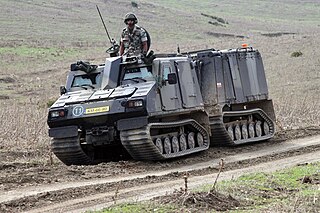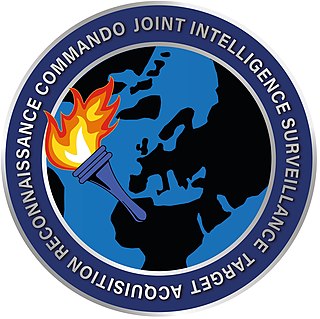
The Royal Netherlands Air Force is the military aviation branch of the Netherlands Armed Forces. It was created in 1953 to succeed its predecessor, the Luchtvaartafdeling of the Dutch Army, which was founded in 1913. The aerobatic display team of the Royal Netherlands Air Force, active from 1979 until 2019, was the Solo Display Team.

The Boxer is family of armoured fighting vehicles designed by an international consortium to accomplish a number of operations through the use of installable mission modules. The governments participating in the Boxer programme have changed as the programme has developed. The Boxer vehicle is produced by the ARTEC GmbH industrial group, and the programme is being managed by OCCAR. ARTEC GmbH is based in Munich; its parent companies are KNDS Deutschland GmbH & Co and Rheinmetall Land Systeme GmbH on the German side, and Rheinmetall Defence Nederland B.V. for the Netherlands. Overall, Rheinmetall has a 64% stake in the joint venture.

The Royal Netherlands Army is the land branch of the Netherlands Armed Forces. Though the Royal Netherlands Army was raised on 9 January 1814, its origins date back to 1572, when the Staatse Leger was raised making the Dutch standing army one of the oldest in the world. It fought in the Napoleonic Wars, World War II, the Indonesian War of Independence and the Korean War, as well as served with NATO on the Cold War frontiers in West Germany from the 1950s to the 1990s.
The Royal Netherlands Army Artillery provides artillery support for the Royal Netherlands Army. It is divided into three corps, undertaking two roles: Korps Veldartillerie - Field Artillery and Korps Rijdende Artillerie - Horse Artillery. These two corps undertake the field artillery role. They are equipped primarily with the PzH2000 and were equipped with the M109 howitzer. Until 2013, one regiment retained the traditions of the Veldartillerie and one of the Rijdende Artillerie, with one assigned to each of the army's mechanised brigades.

Regiment Limburgse Jagers is a light infantry regiment in the Royal Netherlands Army. It is named after the Dutch province of Limburg, and currently serves in the infantry role as part of 13 Motorized Brigade. It consists of 42nd motorised infantry battalion, which is made of three motorised infantry companies equipped with the Boxer APC and MB G280, and a heavy weapons company, consisting of a recce platoon, a mortar platoon with 9 81mm mortars and two anti-tank platoons with Spike anti-tank missiles.

The Regiment Huzaren van Boreel is an armoured regiment of the Royal Netherlands Army, named for Willem Francois Boreel. It currently serves in the armoured Intelligence, Surveillance, Target Acquisition, Reconnaissance (ISTAR) role; the regiment provides armoured reconnaissance squadrons assigned to the 43 Mechanised Brigade, 13 Light Brigade and 11 Airmobile Brigade. An STA artillery unit, an electronic warfare unit, Human Intelligence (HUMINT) unit and imagery intelligence unit are all formed into a single battalion attached to the Combat Support Brigade.

The YPR-765 is a Dutch infantry fighting vehicle. It is based on the AIFV design developed by the FMC Corporation. It replaced the AMX-VCI and YP-408 of the Royal Netherlands Army and entered service in 1977. The Dutch YPR-765s were later replaced by the CV90, Fennek and Boxer.

Spike is an Israeli fire-and-forget anti-tank guided missile and anti-personnel missile with a tandem-charge high-explosive anti-tank (HEAT) warhead. As of 2024, it is in its sixth generation. It was developed and designed by the Israeli company Rafael Advanced Defense Systems. It is available in man-portable, vehicle-launched, helicopter-launched and maritime variants.

The BvS10 is a tracked articulated amphibious all-terrain armoured vehicle produced by BAE Systems Land Systems Hägglunds of Sweden. This vehicle, referred to as the All Terrain Vehicle (protected) - ATV(P) or Viking by the UK forces, was originally developed as a collaboration between industry - Hägglunds Vehicle AB - and the British Ministry of Defence (MoD) on behalf of the Royal Marines.

Lieutenant General Best Barracks, formerly De Peel Air Base, is a Royal Netherlands Army guided missile base in the Netherlands. It has only one, though not actively used, runway.

The 13th Light Brigade is one of the three combat brigades of the Royal Netherlands Army, the other ones being 11th Airmobile Brigade and 43rd Mechanised Brigade. The brigade is a fully motorised brigade, equipped with Fennek, Boxer and Bushmaster wheeled, armoured vehicles.

43 Mechanised Brigade is one of the three combat brigades of the Royal Netherlands Army, the others being the 13th Light Brigade and 11th Airmobile Brigade. The brigade has armored and non-armored vehicles at its disposal, and is tasked with conducting combat operations, peacekeeping and various ceremonial tasks.

The Korps Commandotroepen (KCT) is the elite special forces unit of the Royal Netherlands Army. The KCT traces its origins to the Second World War with the founding of No. 2 (Dutch) Troop, and the founding of the Korps Speciale Troepen during the Indonesian War of Independence. At present, the unit is tasked with conducting the full spectrum of special operations, its principal tasks being direct action, special reconnaissance, military assistance and counter-terrorism.

The current structure of the Royal Netherlands Army is as follows:

The VECTOR is a Dutch light all-terrain tactical vehicle, designed and developed by defence contractor Defenture for use with special operations forces. The VECTOR was developed in close cooperation with the Korps Commandotroepen (KCT) of the Royal Netherlands Army and is tailor-made for use in special operations, providing a combination of high mobility and firepower with light armour.

The Joint Ground-based Air Defence Command is a joint command of the Royal Netherlands Army, formed in 2012 after amalgamation of the Commando Luchtdoelartillerie of the Royal Netherlands Army and the Groep Geleide Wapens of the Royal Netherlands Air Force. The command is responsible for all ground-based air defence tasks and consists of both army and air force personnel. The DGLC employs an integrated layered air-defence approach featuring FIM-92 Stinger, NASAMS II and MIM-104 Patriot systems.

The Joint ISTAR Command is a joint military intelligence command of the Operational Support Command Land of the Royal Netherlands Army. The command is specialised in the gathering, analysis and distribution of military intelligence, and consists of eight operational company-sized subunits.

The ACSV G5 G5 is a family of light tracked vehicles designed and manufactured by Flensburger Fahrzeugbau GmbH (FFG) of Germany. Although it is similar in appearance and design to the American M113, and the company manufacturers modernised versions of that vehicle, the PMMC G5 is an all-new ground-up design.
























